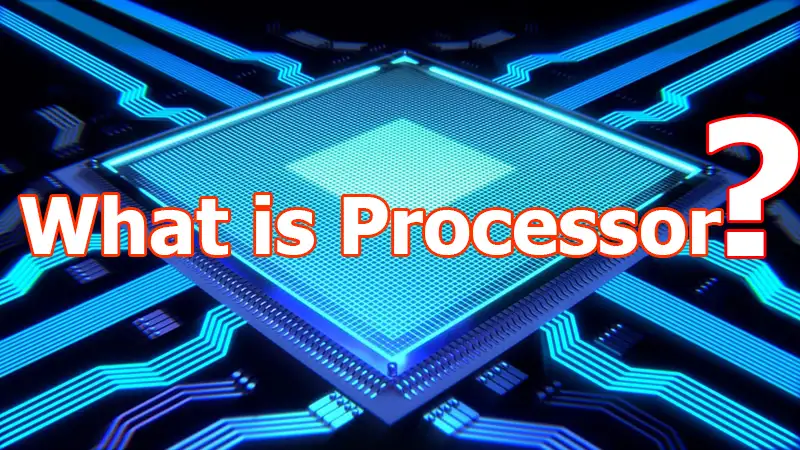First Processor invention:
To be known: In 1971 the first commercially available microprocessor is the Intel 4004.
A processor (CPU) is the logic circuitry that reacts to and accesses the basic information that leads the computer. The CPU is the main key and crucial integrated circuitry (IC) chip in a computer, where it is answerable for interpreting the majority of the computer’s commands. CPUs will support the basic arithmetic, logic, and I/O operations, and even support the commands for other chips and components which are running on your computer.
The basic elements of a processor are listed below:
- Whereas, the arithmetic logic unit (ALU), can carry arithmetic and logic operations on the operands in guidelines.
- Then, the Floating point unit (FPU), also known as a math coprocessor or numeric coprocessor, is a specialized coprocessor that manipulates numbers even at a faster rate than the basic microprocessor circuitry can ably do so.
- Next, is Registers which collects the instructions and other data. Registers stock operands to the ALU and helps to store the results/output of operations.
- LI & L2 Cache memory: in which, the inclusion in the CPU will definitely save comparatively to get data from random access memory (RAM).
What is CPU Operations
You can broadly classify three progressive ways through which you can get your CPU Operations done easily.
- Fetch – It is an operation that helps to receive instructions from program memory directly from the system’s RAM.
- Decode – It is the place where the instruction is converted to make clear commands for other parts of the CPU to proceed next operation. It is executed using the instruction decoder
- Execute – The name itself describes the process, yes, it’s the spot of executing the program. This supports activating each part of the CPU to carry out the instructions.
Components and how CPUs work
The main components of a CPU are the following three parts:
- ALU
- Registers
- Control unit.
As we have already discussed about ALU, Register in the above element of CPU space. Let’s see the control unit and its usage. The control Unit helps to fetch and execute the instructions.
The processor which is inserted through a personal computer or embedded in small devices is denoted as a microprocessor. This term shows that the processor’s elements are controlled in a single IC chip. Some computers will run using a multi-core processor—a chip that contains more than one CPU. Where, the CPU is typically a small device with pins simply facing downward in a motherboard. CPUs can also be connected to a motherboard using a heat sink and on the other hand, a fan to control or dissipate heat.
Types of Processor:
- Microprocessor
- Microcontroller Processor
- Embedded Processor
- Digital Signal processor
Microprocessor
This is the fundamental processor in the system which is represented as a microprocessor incorporated in the embedded systems. On the other hand, we have various types of microprocessors in the market that execute a variety of enterprises. Whereas, the microprocessor is a standard processor which is fully composed of ALU, control unit, and club of registers known as control registers, status registers, and scratchpad registers.
It can be executed as on-chip memory and a few interfaces can be interrelating to the outer world via interrupting lines, and eventually via the ports and memory registers to interact through the external world. In which, the ports are often referred to as programmable and eventually support an output or input. As a result of this, programs can be fed and altered in reference to the behavior of the devices.
In which, one or two microprocessors can be fused together to bring a multiprocessor. Here, the input and output operations and memory are shared by the processors and the access time of the memory register is the same for every processor and it is related to the bus. The methodology is traced on both input and output functions which all are mutually shared by the processor to execute the same function.
Microcontroller
The microcontroller is an effective way in which it is available in different sizes and packages. In reference to this, the input reading and reacting to its corresponding output played the major role/ function of the basic microcontroller and that’s the way it is named a general-purpose input and output processor (GPIO).
There are a few microcontrollers like Microchip P1C16F877A, Microchip Atmega328, Microchip P1C18F45K22, Microchip P1C16F671, and Microchip P1C16F1503 and even more.
Embedded Processor
Here, the embedded processor is structured to restrict electrical and mechanical functions. It comprises numerous blocks like data memory, specific circuits, reset, power supply, interrupt controller, timer, clock oscillator systems, program memory, interfacing circuits, data memory, and system application ports and circuits.
Digital Signal Processor
The digital signal processor is highly utilized for the purposes like filtering, measuring, and compressing analog and digital signals. Here, the accessibility of processing signals is the manipulation and analysis of digital signals.
According to this, operations can be implemented via application-specific integration circuits, digital signal processors, field-programmable gate arrays or it can be a computer to accomplish a diverse signal. Finally, the processors in DSP are used for purposes like barcode scanners, oscilloscopes, printers, and mobile phones. Note: This type of processor is recommended only for rapid and implied for real-time applications.
